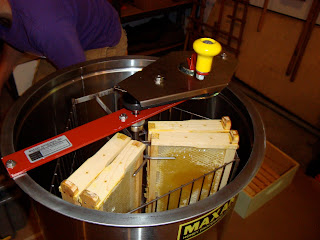 We set up our "Honey House" in our garage. The work zone was covered with Kraft paper for easy cleanup when done.
We set up our "Honey House" in our garage. The work zone was covered with Kraft paper for easy cleanup when done. First with the use of a hot electric knife, the wax cappings (whitish color on frame) which tell us that the honey is at the right moisture (18.6% to be exact!) to be extracted are removed. Instinctively, this honey capping is done by the honeybees; they know when it is the perfect time to put a little amount of wax on each cell full of honey to preserve it without molding.

Then because the thickness of the wax can be uneven at times on the wooden frame and the hot knife cannot perfectly reach the frame's corners; Nicolas uses a capping scratcher ( looks like a big metal comb), to open the missed capped cells.
Now the uncapped frames, exposing the honey are placed in the extractor, vertically. Using the
centrifugal force by turning the yellow handle, the honey is dislodged from the cells and is
"thrown" onto the extractor's wall, dripping slowly downward, thus accumulating at the bottom of the tank..
The wax that is removed from each frame, falls into a double gray plastic bin ( see picture
above, and below) where the first bin has an open bottom, covered with a screen to let the honey go through
but preventing the wax to go into the second container. we collected another pound of honey from the bin.
After filling the extractor with 6 frames, elbow grease is needed! Turning slowly at the beginning and a little faster later on is the trick needed to see honey flowing through the gate.
Ben had to install a space heater on top of the extractor because the temperature that day was barely 70F (21C) and the honey was not warm enough to glide against the extractor's metal sides.
To help the flow of honey further, Nicolas was heating the extracted honey. This process of "lightly" heating the honey made it more fluid which was then easily pass through a set of mesh/filter sieves, obtaining a clean honey...with less potential debris.
We collected a total of : 33 lb. (15 kg) of honey and 5 oz. (300 g.) of wax!













I congratulate you for your work. You share good information. Arıcılık
ReplyDelete